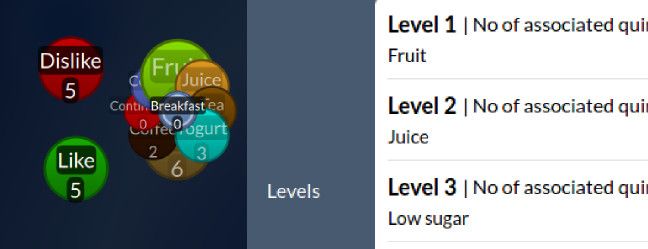Levels: 3-dimensional node and topic grouping in Quirkos
One of the biggest features enabled in the latest release of Quirkos are 'levels', a new way to group and sort your Quirks thematically. While this was always an option in previous versions, they are now fully integrated into the search and query views

One of the biggest features enabled in the latest release of Quirkos are 'levels', a new way to group and sort your Quirks thematically. While this was always an option in previous versions, they are now fully integrated into the search and query views, making them much more useful. However, this is a tricky thing to describe conceptually, so this post will give a few use-case scenarios.
In Quirkos, the topics or themes that you code to (called nodes in Nvivo) are represented as bubbles. These can be moved around the canvas to be grouped by location, given similar colours, or arranged alphabetically or by size. However, they can also be grouped into topics with sub categories, by dragging a bubble onto another one. This creates a parent-child relationship where the parent category, say 'Drinks' can have any number of sub-categories, such as Juice, Tea, Water etc. It is also possible to have sub-sub categories (grandchildren), so in this example, you might have types of Juice such as Orange, Apple and Cranberry.
So far so good – this allows you to quickly see the quotes you assigned to all types of Drinks, or just the Juices using the Hierarchy view. However, this parent-child grouping has a limitation, in that a sub category, say Orange Juice, cannot belong to more than one parent. So we can't describe Orange Juice as being a type of Drink, as well as a form of Fruit.
This is where the 'level' function comes in. A Quirk can belong to any number of levels, which can contain any number of Quirks. So if you created a level called Fruit, by right clicking on any Quirk, selecting the Quirk Properties, you will see all the levels defined in the project, and the Quirk can belong to any number of them. So Orange Juice can belong to a level called 'Fruit', along with Apples, and Oranges, while also being defined as a sub-category of Drink. Alternatively, you could have a level for Drink, and describe some Quirks as being a Drink as well as a Fruit.
The other way that the levels can be helpful is when working on a large project that might have multiple outputs. If you are working on a PhD thesis, or a long report, you might have chapters that only cover certain themes. With the levels function, you can define Quirks that will be relevant to a particular chapter or topic, and see results or reports for just that level. This way, if you are writing about nutrition, the Orange Juice theme can belong to the chapter for Drink and for Fruit, and you will see relevant quotes for each chapter.
To work with levels, just right or long click on any Quirk, and select the Quirk properties. In this box you will see a button for 'Levels Editor', this can be used to define, change or remove levels in the project. Click Save once you are done. Once some levels have been created, you can use the slide toggles shown above in the Quirk Properties dialogue to assign that Quirk to any number of levels. You will obviously need to go though and do this for all the Quirks in the project you want to put into a level.

Once you have done this, you can choose the corresponding level as a filter option in the Query view (LV) or in the search results, to generate reports or see text search results from text coded in one or more levels.
Everyone likes to work with their themes or nodes differently, and now we have many more ways to group and sort them. You can arrange them physically around the canvas, give them meaningful colours, create a grouped stack with sub-category relationships, and also group them by 'level' like an overlapping Venn diagram.
We are going to improve the ways you can work with levels in the future, including visualisations of levels on the canvas, but we want your feedback for the best way you would like to see this! Should Quirks belonging to a level get a certain colour halo, or be shown in a literal 3D level view like levels in a building? Should the canvas rearrange on command to group all Quirks belonging to certain levels together? Is the term 'levels' the right one to use in this situation? The more people are using Quirkos, the more different ways people are working with it, and we want to choose the best and most flexible ideas, so let us know!
